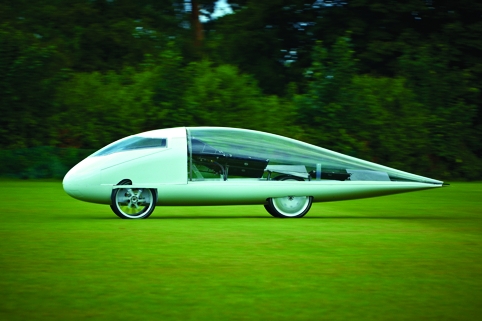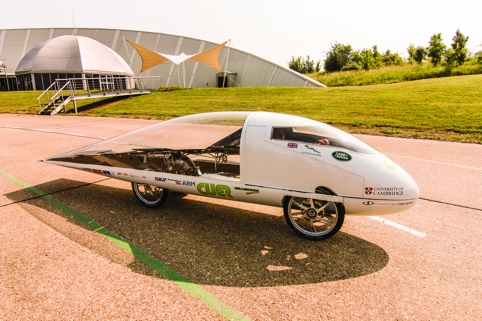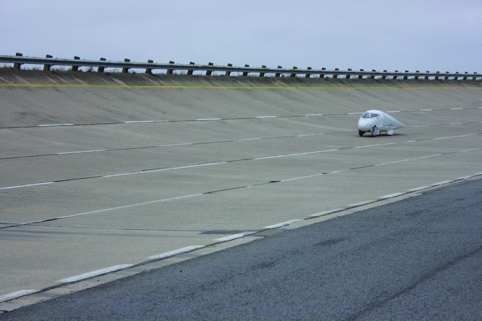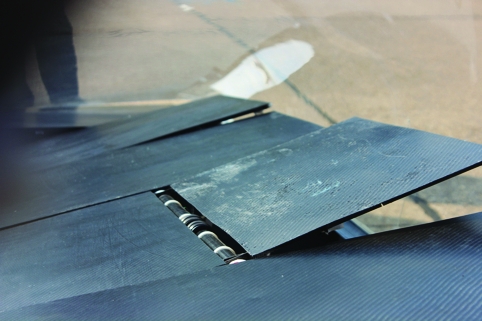It is fair to say that the solar car, although a neat demonstrator for photovoltaic technology, hasn’t had much of an impact on the wider automotive world.
That is perhaps partly because of the unstable-looking ‘rolling coffee table’ design — with its expanse of solar cells, spindly wheels, and cramped driver’s compartment — that has tended to dominate the field.
But now a group of UK students from Cambridge University’s Eco Racing team (CUER) is hoping to prove that a radically different design a step closer to the type of vehicle that might one day appeal to consumers can perform just as well as, if not better than, its less aesthetically pleasing forbears.

Dubbed Resolution — after the ship used by Captain Cook to circumnavigate Antarctica — the vehicle was recently flown to Australia, where it is due to compete in October’s World Solar Challenge, a gruelling four-day-long, 3,000km race across the Australian Outback from Darwin in the north to Adelaide in the south.
An elegant teardrop-shaped vehicle, Resolution looks strikingly different to those developed by other competitors, most of whom, including four-time winner Delft University, have continued down the tried-and-tested route of exposing as much surface area as possible to the sun while optimising their vehicles’ aerodynamic shape.
We’ve decoupled the solar cells from the aerodynamics
Peter Mildon - chief engineer, CUER
Rather than addressing this trade-off, the CUER team has focused its efforts on building the most aerodynamically efficient electric vehicle it could think of, and has removed its solar cells from the aerodynamic equation by placing them beneath a glass canopy and enabling them to track the sun across the sky. ‘We’ve decoupled the solar cells from the aerodynamics’ said the group’s chief engineer Peter Mildon. ‘The canopy means we can have the best aerodynamic shape we can think of while still being able to track the sun.’
Mildon explained that the new design was partly inspired by regulation changes aimed at making competing vehicles both safer and more consumer friendly. In previous years, most designs have placed the driver in a pod at the back of the vehicle above the third wheel, but the rules now stipulate that cars must have four wheels and drivers must have a clear view of the road ahead.

‘The need to have four wheels has prompted a complete redesign for everyone as you can no longer have the driver in a little pod with the single wheel,’ said Mildon.
A lot of the teams have moved the driver off to one side, while others have introduced a fifth pod for the driver in the centre of the vehicle, but the Cambridge team quickly discounted these options. ‘If you’ve got a big driver’s canopy in the centre then for half of the day it’s blocking the sun off the solar cells,’ said Mildon. ‘Plus, we were worried that if you’ve got a driver sat on one side and you have a big cross-wind it would be unstable and flip over.’

With the competition rules now allowing teams to have either 6m2 of standard silicon solar cells or 3m2 of something more advanced, the Cambridge team has also invested heavily in state-of-the-art photovoltaic technology that it believes should help give its vehicle the edge over other competitors. ‘We have a much smaller car, with less aerodynamic drag and at the same time recover almost the same amount of power as the other teams,’ said Mildon.
The car’s performance is further enhanced by the fact that the cells are able to track the sun across the sky. This system — which is moved by linear actuators — uses a GPS tracker to work out the car’s position in relation to the sun and then calculates the optimum position for the solar cells every 15 minutes. Although this approach has been tried in the past, Mildon explained that the presence of a canopy has enabled the team to introduce moveable solar cells without affecting the car’s aerodynamics.

While the ability to track the sun while driving is expected to deliver 20 per cent more energy, Mildon claimed that the system is also likely to prove useful during the 400km stops that World Solar Challenge teams are forced to take. ‘Once on a controlled stop most teams will pick the car up and turn it around so it’s facing the sun — we can do that a lot more easily because of the tracking plate so when we take the canopy off we gain back the few per cent of light we lose going through the canopy.’
One of the challenges of using a canopy is that it could act like a greenhouse, warming the solar cells, and thus affecting their efficiency. To address this, the team worked closely with its main sponsor Jaguar Land Rover and after conducting a series of thermal modelling tests developed an innovative cooling system that uses a series of highly efficient fans to conduct heat away from the solar cells.
Impressively, the group has managed to persuade a consortium of investors led by venture capitalist Hermann Hauser to foot the £250,000 bill for this advanced solar array. ‘Hermann Hauser basically said if you can produce a car that you can demonstrate to me is going to win the race I’ll find you the money for the solar cells,’ said Mildon. ‘We convinced him that we were going to win the race and he’s gone around all his friends and they’ve raised the money. ‘

With just a few weeks to go before the race begins, the CUER team’s confidence remains sky high. ‘Our road speed will be comparable to the times that have won in previous years,’ said Mildon, ‘but we think everyone else will be slower. We are looking to cruise at somewhere between 82-90km/h, but the car will go easily at 100km/h in the middle of the day.’
The question now is whether the car actually brings us any closer to a vehicle that’s appealing for consumers. Mildon believes it does. ‘Because our cells are cripplingly expensive you’re not realistically going to have a car that is powered by the sun from the cells on the car, but what you’ve got with the car is an incredibly efficient electric vehicle. If you had our car with a slightly bigger battery but the same aerodynamics and you put the panels on the roof of your house you could very easily charge it up with the power that you get from the bigger area of your roof with cheaper solar cells. With one charge of the battery you’d be able to commute in and out of London from a suburb for a week without recharging it.’
Resolution was recently the winning entry in the Engineering Showcase, a compeititon organised by engineering recruitment speciaist Matchtech
Click here to read our 2009 feature on the World Solar Challenge
The World Solar Challenge
- The biennial race was established in 1987 to showcase and stimulate research into sustainable vehicles
- The route covers 3,021km (1,877 miles) through the Australian Outback, from Darwin to Adelaide
- This year’s competition, which will see 44 teams competing across three different classes takes place from 6-13 October
- The 2011 winner was the Tokai Challenger from Tokai University, Japan
- The most successful team in the competition’s history is from TU Delft in the Netherlands, which has won the race four times




April 1886: the Brunkebergs tunnel
First ever example of a ground source heat pump?